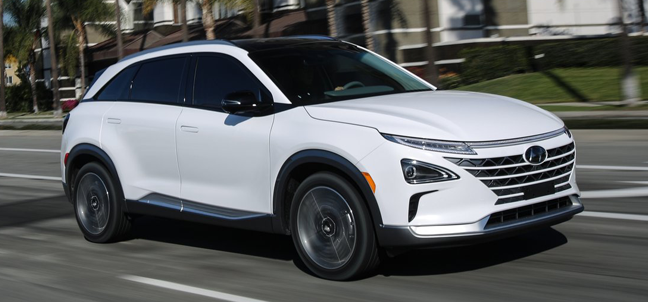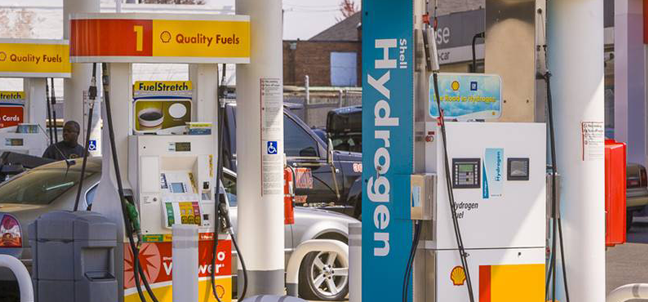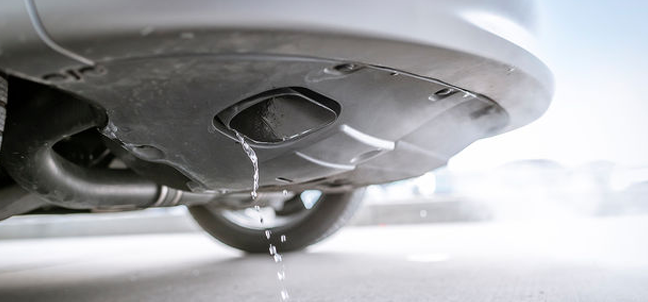Let us walk you through how hydrogen power works with cars, where we currently stand with the fuel and how things may change. Though the technology is relatively new, manufacturers have been working on it for decades, and now we’re starting to see the fruits of their labour. However, there’s still some problems to solve before it replaces petrol at the pumps.
How Can Hydrogen be Used to Power a Car?
Ironically, the majority of modern hydrogen-powered cars are actually electric vehicles! Fuel cell electric vehicles (FCEVs) are almost like electric generators on wheels, using a hydrogen and oxygen-powered fuel cell. Pure hydrogen is injected into a cell and combines with oxygen taken from the atmosphere. The two elements combine in a chemical process called reverse electrolysis that creates an electrical charge. Enough power is generated to power the motors and the only waste from this reaction is water vapour – H2O.
FCEVs are filled from a pump, much like petrol, and have a greater range than their solely electric equivalents. In terms of safety, the highly flammable nature of hydrogen is taken into account, with thick tanks that are regularly checked for impact durability. Many cars are also capable of safely diffusing remaining gas after a serious accident, to prevent explosions.
Right now, there’s two hydrogen cars on the market: the Toyota Mirai and the Hyundai Nexo, with more manufacturers planning to launch their own models. There is a reason for the low amount of production vehicles…

The Practicality of Hydrogen
Although hydrogen is everywhere, finding and storing its useable form – a single H atom as a gas – is difficult. The two best ways is to separate the atom from either natural gas or water. Both of these processes use a large amount of power, the majority of which comes from fossil fuels. This makes hydrogen both difficult to acquire and less environmentally friendly as advertised. There are efforts to try and change this, sourcing renewable energy to power the process.
You may hear hydrogen production defined by colours: grey hydrogen is produced by fossil fuels and is the most harmful to the environment, blue hydrogen is similar but captures and stores the CO2 by-product, and green hydrogen has no CO2 emissions at all.
However, unlike oil’s massive wells and refineries, hydrogen could potentially be produced anywhere with the right equipment, as long as there’s a source of power and water. This could go a long way to bolstering the infrastructure needed for FCEVs; at present there are only 15 hydrogen stations in the UK, a long way from the 32,000 EV charging points.

The Efficiency of Hydrogen
One important factor to consider is the efficiency of energy involved with hydrogen fuel. In simple terms, this is the power required to get fuel to your car – the power needs of extraction, transport, etc. – versus the power your car gets from the fuel. For example, every 1000 joules of energy in petrol might need 100 joules worth of refinement, dropping its overall efficiency by 10%.
A 2020 examination by Transport and Environment looked at fuel efficiencies. Fossil fuels lose more than half of their efficiency before it reaches your car, with only 13% of its potential energy being used to move the wheels. With our present technology – even as potent a fuel as it is – hydrogen is only about 30% efficient, slightly over double that of fossil fuels. Electricity, on the other hand, is a massive 70% efficient, since it comes straight from the grid as it’s generated and energy is only lost from electrical resistance.
But that doesn’t count out hydrogen completely. FCEVs are capable of storing more fuel than their electric counterparts. Some manufacturers are pitching hydrogen as the future for heavy goods vehicles. With greater ranges and quicker refuelling times, fuel cells could be ideal for lorries carrying loads over long distances on a tight schedule. In an industry with a famously large carbon footprint, any green solution needs to be practical in order to win over haulers and manufacturers. Hydrogen fuel might be the thing that starts changing important minds.

At current, we’re still in the early stages of a shift to hydrogen. Some doubt whether a massive paradigm shift will happen and instead propose a world where EVs and FCEVs coexist, whether it’s private versus industrial vehicles, or both being on the road. As the need to move away from fossil fuels grows, the technology behind alternatives will develop ever faster – predictions made now might be thrown off by tomorrow’s new and radical discoveries.